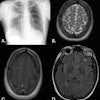
NEW YORK (Reuters Health), Oct 4 - In a population-based study, researchers at eight European centers shed light on the clinical and MRI findings that characterize children with cerebral palsy. The results suggest that obstetrical mishaps play a role in a small proportion of cases.
According to the report in the Journal of the American Medical Association for October 4, previous studies looking at the clinical and MRI correlates of cerebral palsy have been confined to certain disease subgroups or lesion types. Thus, there is need for studies investigating the correlates in a large population of children with all types of cerebral palsy.
The current study involved 585 children with cerebral palsy (CP) who were born at one of the eight centers between 1996 and 1999. Of these children, 431 were clinically evaluated and 351 received a brain MRI scan.
The children included 26.2% with hemiplegia, 34.4% with diplegia, 18.6% had quadriplegia, 14.4% had dyskinesia, 3.9% had ataxia, and 2.6% had other forms of cerebral palsy, Dr. Martin Bax, from Imperial College in London, and colleagues note.
The most common finding on MRI, periventricular leukomalacia, was seen in 42.5% of subjects, the team found. The next most common finding was basal ganglia lesions, noted in 12.8% of children. A completely normal MRI was found in just 11.7% of subjects.
The MRI findings correlate well with the clinical observations and "help reveal the pathologic basis of the condition," the investigators say. They add that this may help "parents, clinicians, and others involved in the care of children with CP to understand the nature of the children's condition and to predict their needs in the future."
Dr. Bax and colleagues conclude that all children with CP should therefore have an MRI scan.
In a related editorial, Dr. Michael E. Msall, from the University of Chicago, calls the present study "a major advance" that makes several "important observations." In particular, he points to the neuroimaging data as being "most informative."
JAMA 2006;296:1602-1608,1650-1652.
Last Updated: 2006-10-03 16:00:20 -0400 (Reuters Health)
Related Reading
MRI predicts neurodevelopmental outcomes in prematures, August 17, 2006
Copyright © 2006 Reuters Limited. All rights reserved. Republication or redistribution of Reuters content, including by framing or similar means, is expressly prohibited without the prior written consent of Reuters. Reuters shall not be liable for any errors or delays in the content, or for any actions taken in reliance thereon. Reuters and the Reuters sphere logo are registered trademarks and trademarks of the Reuters group of companies around the world.

















